Related Research Articles

Skin is the soft outer tissue covering of vertebrates with three main functions: protection, regulation, and sensation.
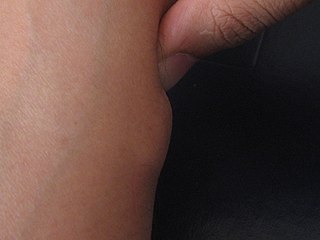
A lipoma is a benign tumor made of fat tissue. They are generally soft to the touch, movable, and painless. They usually occur just under the skin, but occasionally may be deeper. Most are less than 5 cm in size. Common locations include upper back, shoulders, and abdomen. A few people have a number of lipomas.

Phosphatidylcholines (PC) are a class of phospholipids that incorporate choline as a headgroup. They are a major component of biological membranes and can be easily obtained from a variety of readily available sources, such as egg yolk or soybeans, from which they are mechanically or chemically extracted using hexane. They are also a member of the lecithin group of yellow-brownish fatty substances occurring in animal and plant tissues. Dipalmitoyl phosphatidylcholine is a major component of pulmonary surfactant and is often used in the L/S ratio to calculate fetal lung maturity. While phosphatidylcholines are found in all plant and animal cells, they are absent in the membranes of most bacteria, including Escherichia coli. Purified phosphatidylcholine is produced commercially.
A skin condition, also known as cutaneous condition, is any medical condition that affects the integumentary system—the organ system that encloses the body and includes skin, hair, nails, and related muscle and glands. The major function of this system is as a barrier against the external environment.
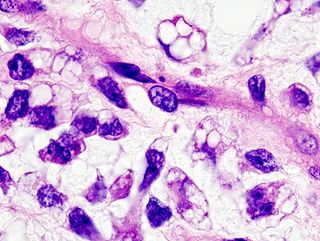
Liposarcoma is a cancer that arises in fat cells in soft tissue, such as that inside the thigh or in the retroperitoneum. It is a rare type of cancer that bears a resemblance to fat cells when examined under a microscope. It is typically a large, bulky tumor, and tends to have multiple smaller satellites that extend beyond the main confines of the tumor. Liposarcomas, like all sarcomas, are rare.

A mastocytoma or mast cell tumor is a type of round-cell tumor consisting of mast cells. It is found in humans and many animal species; it also can refer to an accumulation or nodule of mast cells that resembles a tumor.

Angiolipoma is a subcutaneous nodule with vascular structure, having all other features of a typical lipoma. They are commonly painful.

Lipoma-preferred partner is a protein that in humans is encoded by the LPP gene.
Frontonasal dysplasia (FND) is a congenital malformation of the midface. For the diagnosis of FND, a patient should present at least two of the following characteristics: hypertelorism, a wide nasal root, vertical midline cleft of the nose and/or upper lip, cleft of the wings of the nose, malformed nasal tip, encephalocele or V-shaped hair pattern on the forehead. The cause of FND remains unknown. FND seems to be sporadic (random) and multiple environmental factors are suggested as possible causes for the syndrome. However, in some families multiple cases of FND were reported, which suggests a genetic cause of FND.

A hibernoma is a benign neoplasm of vestigial brown fat. The term was originally used by Gery in 1914.
Neural fibrolipoma is an overgrowth of fibro-fatty tissue along a nerve trunk that often leads to nerve compression.
Chondroid lipomas are deep-seated, firm, yellow tumors that characteristically occur on the legs of women. They exhibit a characteristic translocation t(11;16) with a resulting C11orf95-MKL2 fusion oncogene.
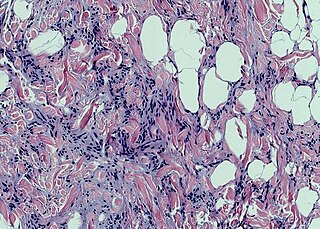
Spindle cell lipoma is an asymptomatic, slow-growing subcutaneous tumor that has a predilection for the posterior back, neck, and shoulders of older men.
Intradermal spindle cell lipoma is distinct in that it most commonly affects women, and has a wide distribution, occurring with relatively equal frequency on the head and neck, trunk, and upper and lower extremities.
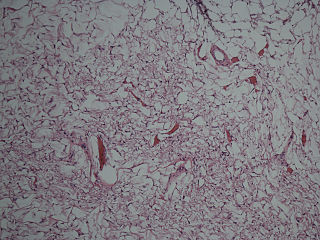
Lipoblastoma is a type of subcutaneous benign fatty tumor.
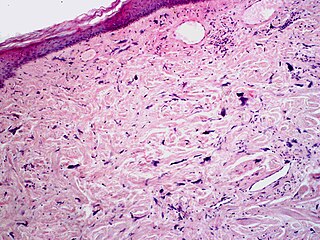
Pleomorphic fibromas of the skin usually present in adults, with a slight preponderance in women.

Mammary myofibroblastoma (MMFB) is a rare, benign tumor of the breast.
Epithelioid cell histiocytoma is a rare skin condition that is considered to be a variant of a dermatofibroma.
References
- ↑ James, William; Berger, Timothy; Elston, Dirk (2005). Andrews' Diseases of the Skin: Clinical Dermatology. (10th ed.). Saunders. ISBN 0-7216-2921-0.